An Echo Resounding by Traveller
Let's make a map
Original SA post An Echo Resounding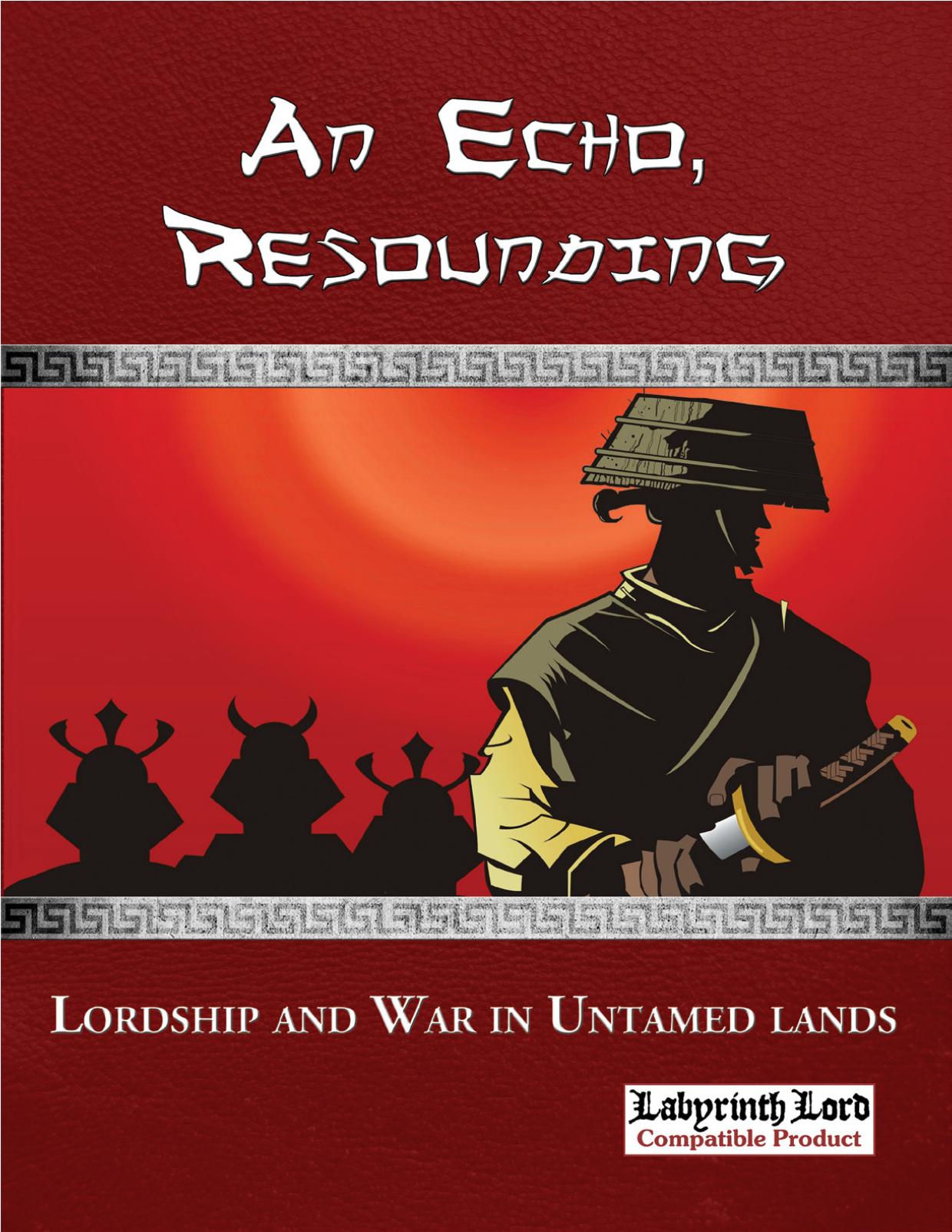
Oh right, the cover image.
Another OSR writeup for you! This one is for Kevin Crawford's domain management/mass combat supplement for Labyrinth Lord, An Echo Resounding. It has tools to generate domains both PC and NPC-run, get armies to smash each other in the field, and also includes a premade campaign region for adventuring in. It uses the Red Tide setting as a base, but knowledge of it is not required to use AER, even if some design quirks answer to it. The supplement itself as well as its chapter titles and subheaders are taken from verses of the Zen poet Ryôkan, which is a nice touch.
What is domain play ? If you picked up this supplement you probably already have an idea of this, but anyway: domain play broadens the scope of the game from the personal-scale adventuring of PCs to the conflicts between major political powers and important local rulers, where PCs can be the movers and shakers themselves or important agents for these powers. At this level, the interactions between domains (cities, states, and more) set the events of the campaign world, and PCs in a sandbox campaign can choose to become involved with them or simply watch from the sidelines. Even if the PCs are just random murderhobos, these events can serve as background material; if, on the other hand, they're involved from the start, they can have stakes in their relationship with the local powers from the get-go. Perhaps PCs can't just go and topple the local tyrant from level 1, but that gives them an obvious motivation to become stronger, and friendly lords can be counted on for support later on. Finally, it makes their transition from wandering adventurers to local rulers smoother, instead of just granting them a plot of land at level 9. You don't just take over a village when you hit that level, you become its ruler by popular acclaim because you saved it from a powerful demon three levels ago and they really need a strong protector. Indeed, PCs can become agents of a domain or even its rulers way before they hit level 9, where their ability to recognize and solve political issues can matter more than how many HP they have.
So how do you, as a GM, sell them on the idea of domain play? It is possible that some players feel it adds nothing to the game, as their characters are freebooters and wanderers and they are uninterested in politicking or diplomacy. Of course the game works better when everyone is on the same page, but hey, if they're not interested the GM shouldn't force the issue. There will still be adventures to go on, and uninterested players only need to give some twenty minutes each session to the players that do want to get their ruling on. Other players may worry that becoming rulers may overshadow PCs without their own domains, or that they must have a domain of their own to match up to them. Well, even rulers need heroes, because even with armies at their disposal the hardest problems are usually ones that require hand-picked, elite operatives to solve. Some players may feel it's too early to worry about domain play at level 1 when characters are barely scraping trying to survive, but having rulership as a possibility in their minds from the start is good in the long term. Players tend to stick to what they feel are the limits of a sandbox campaign, so getting them into the mindset that yes, seeking political power is a perfectly acceptable goal can make them more amenable to actually doing so if they wish.
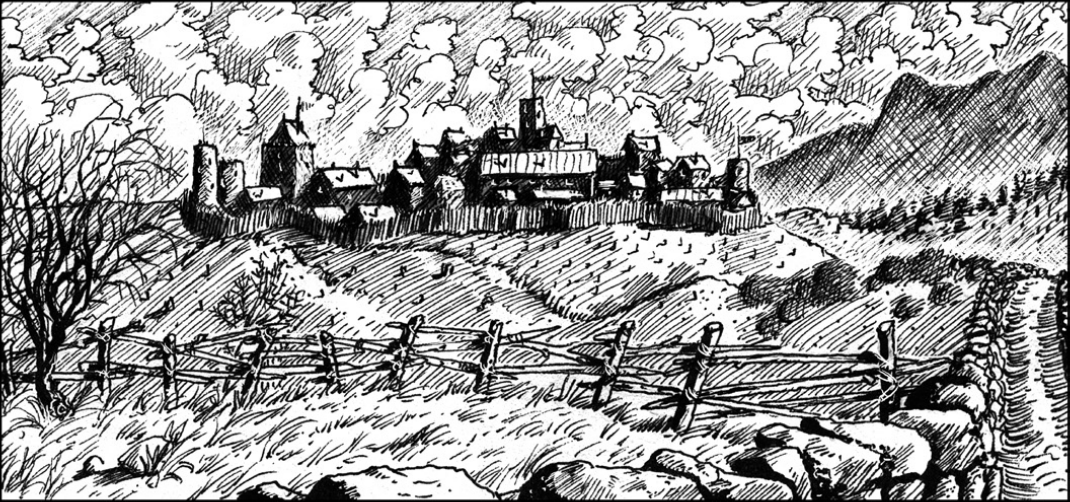
How quaint and peaceful! Then the PCs arrived.
The AER rules assume that domains are essentially border states: regional powers at a modest scale. City-states, crumbling federations, perhaps ruling directly over no more than some market towns, a great city and its satellites. This level of government is the most useful at the table, as gigantic empires tend to be so remote that individual PCs have little to no influence in them, and there's no excitement (read: bloodshed) if a whole region is under the thumb of a single power. This is a more personal level of government, where armies are measured by the thousand instead of the million and nobles can be approached plausibly. Not that it can't be scaled higher, but we'll get to that later.
Concepts! A region is the area where the GM expects the campaign to spend the largest amount of time, around 300 miles a side. That much room will keep the PCs busy long enough that when they want to strike out in new lands, the GM will have enough forewarning to prepare new content. The base building block of a region is the location , which is simply any place of interest to PCs or strategically valuable to a ruler. Villages, towns, good farmland, mysterious ruins, the only pass through a mountain range - those all are locations. When PCs go to a location, they will find something interesting. Note that not every single hex in a map has to have a location, and indeed GMs are warned not to overbuild at this stage - yes, they're setting the foundations of late-game play from the start, but the strain of detailing every single square kilometer would bring most GMs to boredom, collapse and the end of the game. Locations are rated by Military , Wealth and Social values. Military represents the location's contribution to the martial power of its owner; Wealth, the value of the crops, treasure or local expertise; Social, the able-bodied population and their general morale and cohesiveness. A small town may have Wealth and Social bonuses while not contributing Militarily, while a great fortress may have a great Military value but be an actual drain on its owner's Wealth. Locations often have traits , special qualities about them that set them apart from others of their type. Sometimes beneficial, sometimes negative, they're also handy plot hooks for the GM to use in a game. Locations can also have obstacles , traits that make the location uncontrollable or difficult to manage until suppressed or eradicated. Maybe the town is packed with rebels and separatists, maybe the farmland is suffering of plagues, and so on. Sometimes these maladies can be expunged by the force of arms, sometimes they need judicious evangelists or an injection of wealth, and sometimes adventurers need to get involved. These always exist in untamed locations, but sometimes they can pop up in pacified locations under the control of a domain. Finally, locations have assets , which can be mobile (e.g. military units) or immobile (schools, shrines, even local customs.) Mobile assets can seize or defend locations, or overcome obstacles; immobile assets provide a myriad benefits to their owners. Creating a region means creating a set of locations, giving them traits and obstacles, and setting up local domains the GM wishes to use. As the game progresses, the domain management rules can be used to play out conflicts and determine new obstacles, giving the PCs a living background for their adventures, and eventually the hooks they'll need to come to power.
To create a region, first you sketch a map, in whatever way is most comfortable for you (hex mapping, freeform, etc.) Hell, you don't strictly need an actual, drawn map. It should be scaled to the planned campaign, and the rest of the world can be safely ignored for the moment. At this stage, minor centers of population can be ignored, and you can focus only on the major Cities and Towns within the region. Pick a likely location and put down a City, usually near the coast or a large river. Most regions will only have one City, but some particularly populous or well-developed regions may have as many as three or four. Try to put them away from each other - unless the region is particularly rich, their close proximity will strain available resources. These cities will have around ten to fifteen thousand people. Next, place four Towns for each City on the map. These can be placed more freely, not relying as much on shipments of food or fisheries to support their populace. Spread them out fairly evenly across the region. Then, start placing Ruins : lost temples, dead cities and more. Plant five Ruins for each City. One to three of them should represent once-major human inhabitations, while the rest can be wizard's towers, pre-human ruins, and other likely locations. At this stage, just placing down the locations of everything is enough. Next come Resources , which are locations with something useful or valuable to a domain. Rich fishing grounds, good farmland, sturdy timber - these provide stuff. Take a number equal to the number of Towns in the region and spread them evenly, somewhat far from any urban center that could otherwise exert easy influence upon it. While a resource can be spread over a large area, the fixed location you're setting in here is its center or the strategic location that allows a domain to control the resource: for instance, the entrance to a large, sprawling underground mine. Moving on, you have to set down Lairs : these are the homes of monsters, bandits, and other undesirables that plague the local powers. They may not be literal monsters, but there's definitely something repugnant about the locals - otherwise, they wouldn't be living in a Lair. Identify obvious land and water routes between settlements, then place a Lair roughly equidistant between them. They're the reason why these border regions are so dangerous, preying on travellers and needing the strong arms of adventurers to be rooted out. Identify isolated Resources far from a Town or City, and put three or four Lairs with good access to them. Then, wherever you see an empty hole in the map, place a Lair there too.
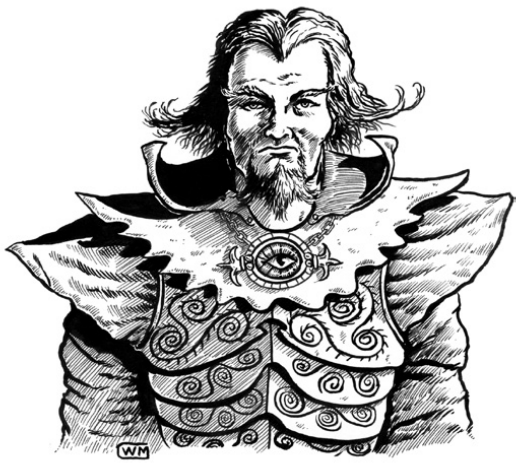
Whoever this guy is, he doesn't look too pleased.
Then, start naming the locations according to your preferences and campaign setting, and give each City, Town and Resource an Obstacle . This is what hinders the location's usefulness for a local Domain until it is removed. Each Obstacle has a level from 1 to 8. Assign these by hand, or roll 1d6+2 if you're not sure about it. Finally, establish the local Domains , the polities that act as a single unit under the rule of a nobleman, wizard king, and so on. They may be fiefs of some distant empire, but it is assumed that outside powers are too weak, distant or indifferent to interfere with their workings. Not every single settlement in the region has to be part of a Domain, and most Domains won't be particularly large: one City, a few Towns maybe, or even just a single Resource. Place the Domains in neighboring pairs or triads to generate tension and conflict, which doesn't necessarily have to be violent in nature, or just plop them near some convenient Lairs. It is assumed that the Obstacles of a Domain's locations are already overcome by their rulers - they're there if someone else wants to muscle in.
If you wish, you can also create a Hall of Infamy , which is the collection of major enemy NPCs that the players can be expected to face in a full campaign. These don't have to be scaled to the party's level, and indeed you can and should create foes that are too powerful to take on directly to preserve the sandbox flavor. These NPCs will have large goals at hand, we're not talking about the mad wizard locked in his lonely tower here. This way you don't run the risk of the party asking why they hadn't heard about the evil archlich they just defeated until they hit 12th level. The Hall is stocked at the top first, by creating the biggest, nastiest danger in the region: the lich, the tyrant with literal divine grace, the burgeoning Tide Cult, and so on. It doesn't have to be an imminent threat, but it has to be doing something that the PCs can notice. This danger will have a level equal to whatever level you expect the PCs to reach at the end of the campaign, which admittedly is a wild guess given how fragile campaigns are, but it's easier to scale downwards than up. This great danger will usually exist in a Ruin or Lair, but it might just be a City's ruler. Once this prime evil is chosen, create two lesser threats, the kind that would take a 9th level party to take down. Secret cults, sinister cabals, monsters capable of having retinues of their own. These can be attached to Cities, Lairs or Ruins. Under them, make four significant perils to be faced by mid-level PCs : major warbands, aspiring warlords, maniac wizards. These are usually assigned to Lairs. It's not necessary to generate any other bad guys before hand beneath these, no one will wonder why they hadn't heard of lesser foes beforehand.
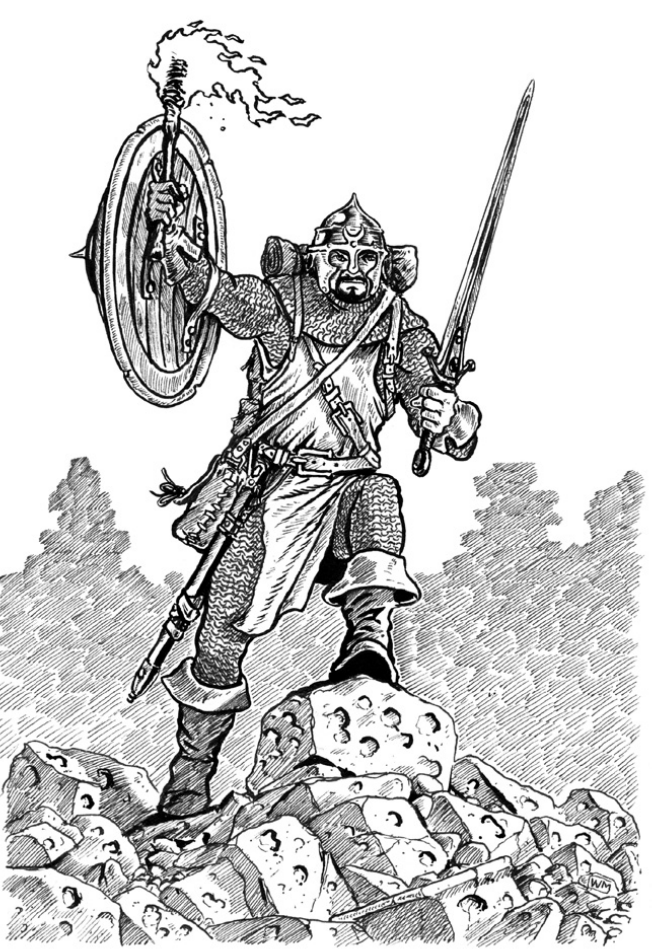
Why does he have a torch lit up while standing on the surface? Doesn't look like it's night or anything.
And the map is done, but it doesn't mean it is unchanging. As the PCs move along it they may actually end up creating new locations with their adventures, or see previous locations razed by war or other calamities. If the PCs pay particular attention, you can mark it as a Place , a minor location without any domain value or traits. Most villages and farming hamlets can qualify as one. These Places, depending on how the game goes, can become major locations on their own. Then we have some notes on leaving the boundaries of the map (in which case you don't necessarily need to create a new region, just enough for the PCs to adventure in then return to the campaign region), or retrofitting existing maps. Locations don't have exact numbers for people, you can wing it, but there's still some guidelines if players and GMs do get a kick out of establishing exactly how many people can live in a particular hex.
Next: we're going to the obstacle course.
Domain management and mechanics
Original SA post An Echo ResoundingLet's take a look at how locations actually look from a mechanical point of view. Cities provide +4 Wealth and +4 Social points to the domain that controls them, while Towns give +2 Wealth and +2 Social. Each City or Town has an Origin and an Activity that further modifies these values: for instance, the Town of St. Alicia may have been founded by a Religious Community (+2 Social) and have a local Martial Tradition (+2 Military). Ruins provide +2 Wealth to their owners, with their Nature and Traits providing an extra bonus - an Abandoned Town gives +2 Wealth, a Crumbled Fortress gives +2 Military, and they may house Forgotten Sorceries (+2 Military) or Great Art (+2 Social). Resources give +2 Wealth by default and the Type of resource can be rolled, but by default they all add +2 Wealth (Good Fishing, Good Hunting, Good Mine, etc.) though the GM can say that, for instance, a colony of sorcerous artists provides a Social bonus instead. Lairs also have Natures , which in this case involves determining what group of gribblies has the Lair as home. Depending on the type of Lair, it is more or less dangerous to the surrounding settlements and easier or harder to attack - for instance, an Ancient Fort full of bandits sends an unit of Light Infantry to raid a location on a roll of 5+ on 1d6 each domain turn, and it is defended by 3 Light Infantry, 2 Archers, 2 Barriers, 1 Tower and 1 Veteran Sergeant.

She has streamers in her head, your argument is invalid.
Now, we also need to roll Obstacles for those beneficial locations, but while each type of location has Obstacles of its own I chose to put this at last because they all follow the same structure. Obstacles reduce the benefits of a location in half their level, and they must be removed either by PC action or by a domain ruler taking a Solve an Obstacle domain action, where they send an asset to deal with the issue (we'll go in detail over these actions later.) Obstacles are divided in Military, Wealth and Social types, and each type has two subdivisions:
-
Disorder
(military) - requires a Guardsmen unit
-
Uprising
(military) - requires any military unit
-
Poverty
(wealth) - requires a Merchant unit
-
Ignorance
(wealth) - requires a Sage unit
-
Despair
(social) - requires a Prophet unit
-
Corruption
(social) - requires a Magistrate unit
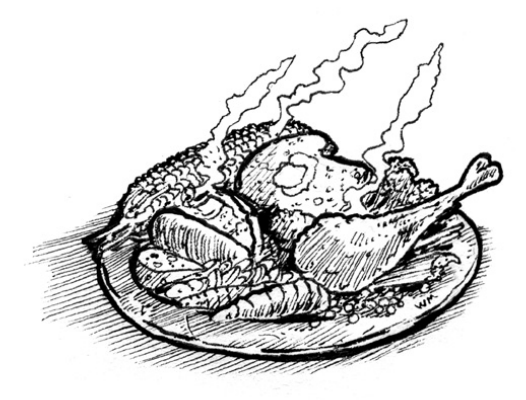
Obstacle: Delicious Cooking, populace is growing fat.
Rulers need to send the right type of unit to deal with an obstacle: one of the right type but wrong subdivision sees the Obstacle's level doubled for the appropriate saving throw, and one of the wrong type and subdivision sees it tripled. Sure, your company of hardened heavy infantry can quash an open rebellion just fine, but they'll have trouble putting down a criminal organization with fences and infiltrators among the populace, and they'll have a world of trouble dealing with a population so dismayed by poor crops they're basically sitting and waiting to die. Each Obstacle entry has a small description, the way in which an asset can deal with it and how PCs can get involved, so they're not only useful from a purely mechanic point of view: each of them is a plot seed for a game. For instance, Ancient Dead (Military/Uprising) is exactly what it sounds like, dead rising and being spooky and hating the living, and only brute force will purge them - but sometimes some more powerful varieties of undead are immune to ordinary weaponry, forcing the entrance of specially trained exorcists or veteran adventurers. Bad Feng Shui (Wealth/Ignorance) gives a location unexplicable streaks of bad luck, and expert sages and geomancers might be able to surmise how to best align new foundations, monuments and structures to redirect the local energy flow, or adventurers may be needed to dispatch some malevolent supernatural being or hunt down the cursed artifact causing the bad luck. Demagogue (Social/Despair) has the local populace in thrall of a zealous demagogue, one that preaches hatred to outsiders or has them spending all their spare effort in some aggrandizing cause. A new, better belief needs to take hold to root the demagogue out, one more amenable to peaceful cooperation, but when that fails adventurers need to be sent in not simply to kill the demagogue, but to find proof of their falseness and venality. It's up to the PCs to determine what can be solved using their Domain's assets, and what requires personal attention or is more interesting to tackle in a way that isn't just a couple of dice rolls.
Domain management! At last, here we have the rules. Domains have three stats, Military, Wealth and Social. Locations and assets add to these stats, and many assets also have an upkeep cost, limited by the domain's stats. From 1 to 5, a stat has no modifiers; At 6+, a stat has a modifier of +1, at 11-15 +2, at 16-20 +3, and +1 more for each full five points. A domain check requires the ruler to roll 1d20 and add the relevant stat modifier to the roll, while a domain saving throw requires to roll under 12, modified by the relevant stat's modifier. There are six saving throws, each for one of the different Obstacle types. Domains also possess assets , that can be anything from a military unit to an intangible Domain-wide custom. These rules work with domain turns , an undefined period of time that by default is around a month of game time. NPC-ruled Domains get one action per turn, PC-ruled ones get two per turn simply because PCs. A Domain needs at least one location to exist, and usually at the start of a campaign there will be many locations not held by any Domain in particular. To take a location, a Domain must solve its Obstacle (with possible interference and sabotage from other Domains), then negotiate with the location's leadership or outright take over if it's devoid of inhabitants. It's at the GM's decision which assets, if any, can be transferred to new rulers: just because a grand temple stands in the town it doesn't mean the church elders will automatically like the new management even if the secular leaders are okay with it, and so the domain won't get the benefits of owning it. Locations must also be accessible from lands already held by the Domain - if you want a far-off Resource, you better be willing to take over all the locations in the way.
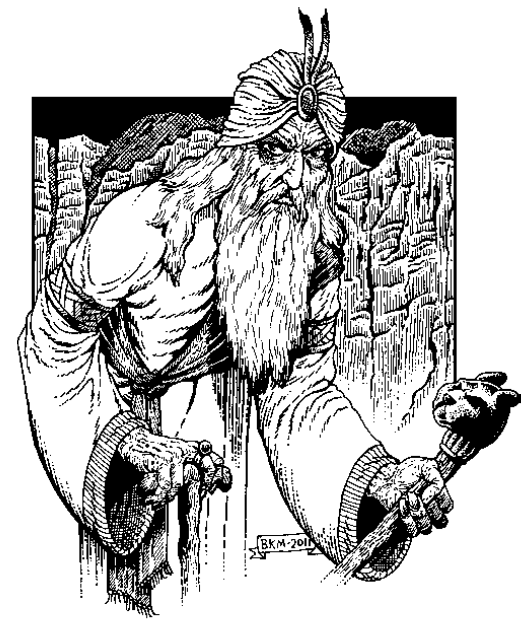
Wizened dude is wizened.
It is assumed that PCs will be reasonably clement lords, but also that the border Domains that these rules focus on have some degree of roughness built into them. Death penalty and judicial slavery are not uncommon. However, when rulers go beyond the pale, they engage in Atrocity. After a check or saving throw is done and failed, a ruler may add Atrocity points as necessary to make it a success, but they must also describe just what horrible deed they're committing: the sample involves failing a roll to raise an unit of infantry, then the ruler having their enforcers round up and crucify some peasant children so that their families place less stock in the value of their children's lives.
 A Domain that possesses any Atrocity points at all takes a 2 point upkeep penalty to all of its values because living under the yoke of tyranny isn't exactly conducive to well-being and productiveness. For each four points after that, another upkeep point is added. Some "evil" assets can help deal with the tax of Atrocity, but they have their own disadvantages. Atrocity breeds dissent and opposition, and so when such a tyrant ruler is deposed the Atrocity value of the Domain is used to purchase units representing rebels, bandits and survivors, to add to the chaos of the Domain's fall. Founding a Domain requires nothing more than a location, even a shitty little village, and the GM's permission. Destroying a Domain is also straightforward enough - capture all of its locations.
A Domain that possesses any Atrocity points at all takes a 2 point upkeep penalty to all of its values because living under the yoke of tyranny isn't exactly conducive to well-being and productiveness. For each four points after that, another upkeep point is added. Some "evil" assets can help deal with the tax of Atrocity, but they have their own disadvantages. Atrocity breeds dissent and opposition, and so when such a tyrant ruler is deposed the Atrocity value of the Domain is used to purchase units representing rebels, bandits and survivors, to add to the chaos of the Domain's fall. Founding a Domain requires nothing more than a location, even a shitty little village, and the GM's permission. Destroying a Domain is also straightforward enough - capture all of its locations.
A Domain's leader has perks: they get lodging, servants, and a proper lifestyle.They also get a personal guard, usually of high Morale, but normally not cut out to go on adventures and dungeon delving. They can also call on a certain measure of goods and services, around 100G for each Wealth point possessed by the Domain. And of course, they get to use the Domain's assets in whatever way they deem fit: a temple can be counted on to provide healing, a school will train a promising pupil sent in by the ruler, and so on, as long as the ruler isn't being pushy and monopolizing their activities. It is assumed that PC rulers can go on adventures without their Domains falling into chaos: their viceroys and seneschals will handle things for them, and even if they can be a little corrupt on the side they won't actively harm the Domain or betray the PCs unless the PCs have been actively shitty to them. Players don't need to worry about sudden backstabs or anything because this isn't a grognard game like Houses of the Blooded.

Some notes on scaling things up (a 100-man unit is now 1000-man; a City is now a whole conurbation; and so on) we get the list of domain actions!
-
Accumulate Treasure
: Wealth check against 8 + current Treasure. On success, 1d4 Treasure points are accumulated, which can later be used to grant bonuses to later rolls (+1 for the first point, then two points, up to a maximum of four). If the Wealth check fails, PCs may spend 1000G per point of Wealth possessed by the Domain to reroll it, with no refunds if this also fails - it is assumed the money was lost in bureaucracy, ineptitude or fraud.
-
Attack a Location
: we go to war! A military unit can reach as far as they can go from their current location within a domain turn, but units sent from different locations won't arrive at the same time, so usually a nearby staging ground needs to be set up first.
-
Disband an Asset
: one or more assets cease to exist. Customs can normally not be disbanded unless their upkeep cannot be maintained, and forced suppression of them can generate rebels and Obstacles at the GM's discretion.
-
Establish an Asset
: raising a unit or building an asset needs three checks, one for each stat. The difficulty for each check is 12 + the absolute value of the asset's benefit or upkeep. Once all three rolls are successful, the asset exists, but each failed roll also reduces the difficulty in 1 point. A Domain can have as many assets as they can maintain, but they cannot have multiple immobile assets of the same type in one location (no more than one School, for instance). Customs are special assets that affect an entire Domain and in addition to the checks they require GM consent, and some assets require other assets to exist (for instance, a Great Temple needs a Shrine before it can be built) It's up to the GM whether an asset can be built in any given location.
-
Establish/Erase a Location
: pop, a new location exists. It does not have any value and usually isn't enough to sustain a Domain if all of its other locations are captured. Maybe it's the site of a new summer palace, or a military camp. Alternative, you can raze a location you control, if plausible within a domain turn. Undoing such destruction takes 1d6+6 domain turns if the GM judges it possible at all.
-
Move an Asset
: units can be moved up to their maximum overland travel rate for the domain turn's time frame. Immobile assets can't be moved, heh.
-
Punish Atrocity
: the ruler convinces the populace that some unlucky scapegoat is the culprit of all the Atrocity going on. First, Establish a scapegoat asset (the checks' difficulties are 5+current atrocity), then disband it fatally
 to remove 1d4+2 Atrocity points from the Domain. This action can be taken once a year.
to remove 1d4+2 Atrocity points from the Domain. This action can be taken once a year.
-
Rectify Disruption
: Remove 1d4+2 Disruption points from an asset.
-
Repair an Asset
: heal as many HP on damaged assets as Military points the Domain has. Scarce units need 2 points to heal 1 HP, Rare units need 4 points for 1 HP. Units cut off from supply can't be repaired.
-
Solve an Obstacle
: send an unit to deal with an Obstacle. Make the relevant saving throw, on a success the Obstacle's level is reduced in 1d4. On failure, the unit gains a point of
Disruption
: every time a Disrupted unit is ordered to do something, roll 1d6, and if it's equal to or less than its Disruption value it does nothing. Obstacles recover one point up to their maximum level if left alone.
-
Withdraw Treasure
: 1 point of Treasure can be converted to 500G, then two, then three and so on.
Then we have the list of immobile assets and customs, each with their own value bonuses/upkeep and special traits. For instance, a School gives +2 Wealth and the services of a 5th level magic user, while Dwarf Friend (+4 Wealth) lets the Domain recruit dwarf units (but, in Red Tide tradition, it can never have anything to do with chattel slavery lest they lose this friendship) A Mercantile (+4 Wealth) domain doubles the benefits of Markets, Trade Centers and Mercantile Guilds, while a Necromantic Cult (-2 Social) allows the recruiting of undead units with a 2 Atrocity cost per each unit. Slavery (+4 Wealth, -2 Social) removes the upkeep costs of a single asset in a location but makes dwarves hate the Domain. A Militia Muster (+1 Military) allows the creation of 2 Militia units if the location comes under attack, an Organized Militia (+2 Military, -1 Wealth) raises this number to four Militia, and a Veteran Guard (+4 Military, -2 Wealth) turns the Militia into Heavy Infantry. And so on. In the game example at the end of this chapter, we see that the GM has a lot of leeway in doing things: the PCs decide they want allies and impress a local Gadaal village enough that the GM rules that they give them one unit of scouts without upkeep, justifying it as there are enough unclaimed resources in the land and the Gadaal want to strike at the common foe they have with the PCs badly.
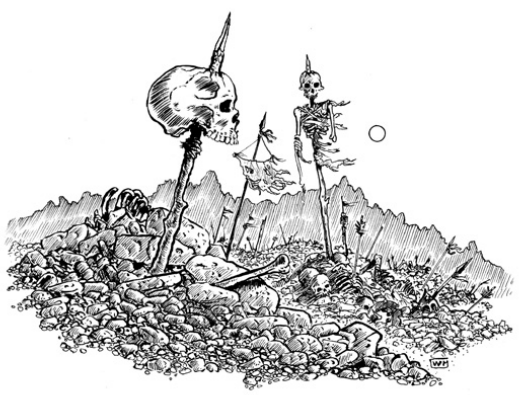
Yes yes, nice fantasy Civ, but where's the war?
Next: to battle!
A red day, a spear day
Original SA post An Echo ResoundingA red day, a spear day
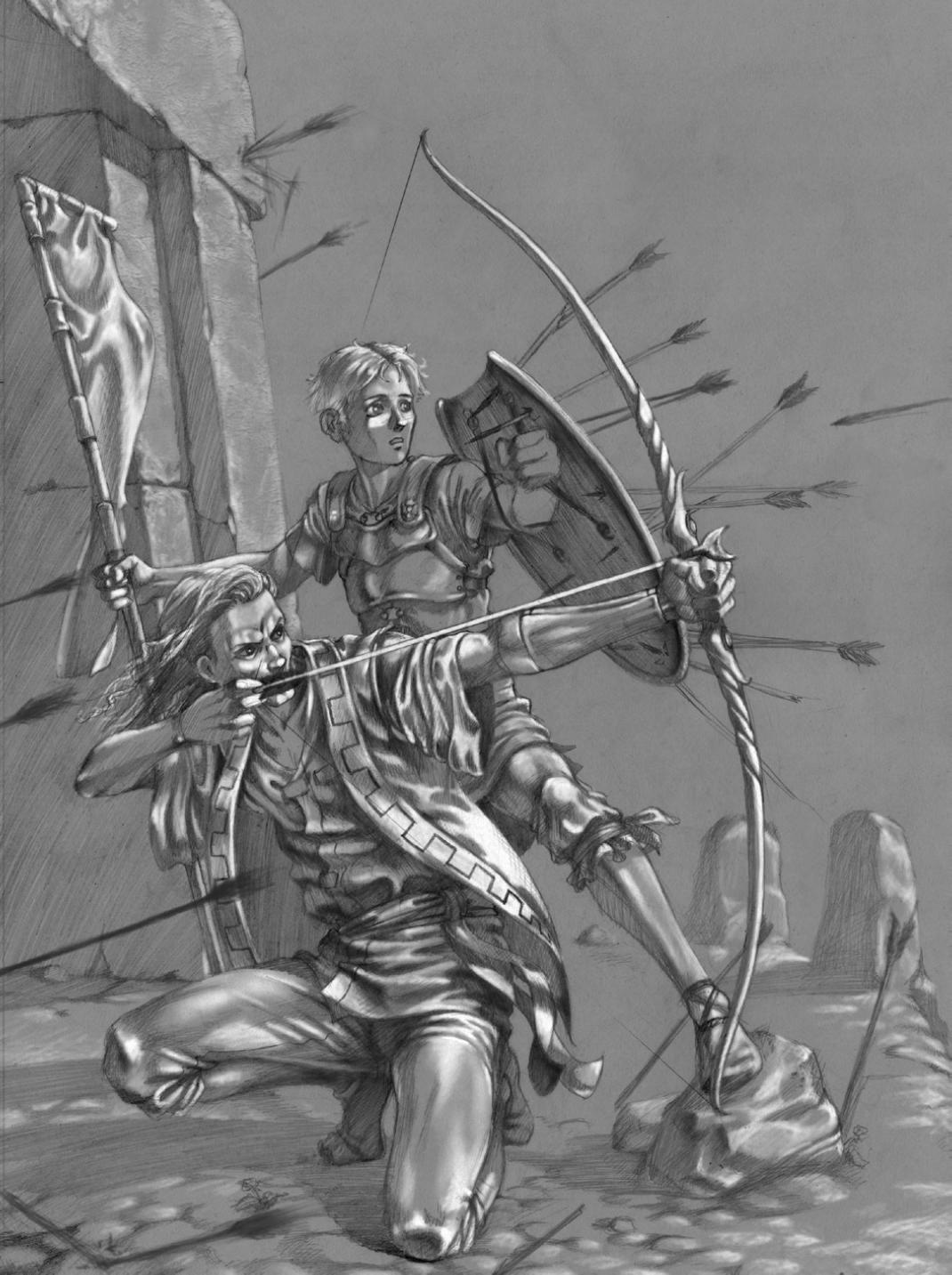
Less shooting, more finding cover jesus
Okay, so how do we go to mass combat ? Quite simple. The main element of mass combat is the unit , that represents about 100 humanoids or a lair's worth of monsters (so an unit of say, hill giants comprises eight of them). A unit has the same stats as its base creature, so our hill giant unit has an AC of 4, 8 HD, a Morale of 8, and so on. Well rested and at full strength, it also has the maximum amount of hit points possible, so our hill giants have 64 HP. Units retain the same special abilities as their base creatures, so hill giants can throw rocks, pegasi can fly, and so on. Spellcasting is special, as we'll see later. Some particularly fearsome creatures (like big demons, dragons and shit) as well as certain special champions get to be units on their own called Heroes , but we'll deal with those in detail in the next post. Some units are not meant to stand on the battlefield on their own, but are attached to others, and they are known as Support units. Here we have assassins, bodyguards, specialists, and so on. Low to mid level PCs often qualify as Support.
Mass combat plays out pretty much the same as individual scale combat. Side initiative is rolled (with ties rerolled as the only major difference), units are moved, then missile fire happens, then spells and then melee combat. Units move their normal outdoor movement rate in combat in a round, reduced by difficult (1/2) or very difficult (1/4) terrain, and movement is automatically ended if they come within 20 yards of another unit or a Hero willing to melee them. If the moving unit initiates the attack, it is placed in contact with the defender and they enter melee. Units stay in melee until they're defeated, to retreat in order they must pass a Morale check, or they must either remain in place or be Routed. One unit can be at most in melee with four enemy units (one per side) and any number of Heroes, while Heroes themselves can only be engaged in melee with one single unit. Missile units can pile their fire on an enemy unit or Hero if they wish, however. Morale is checked when a unit first suffers damage in a battle, when an ally unit is routed or destroyed, when half the allied force is routed or destroyed, and when the unit is reduced to 1/2 or less HP. Failing this check makes the unit Shaken , suffering a -2 penalty on attack rolls and a -2 penalty to Morale. Shaken units that fail a Morale check are Routed , and they must attempt to flee the battlefield, can no longer attack and take double damage. Units can withdraw from the battlefield without being Routed simply by reaching the edge of the battlefield.
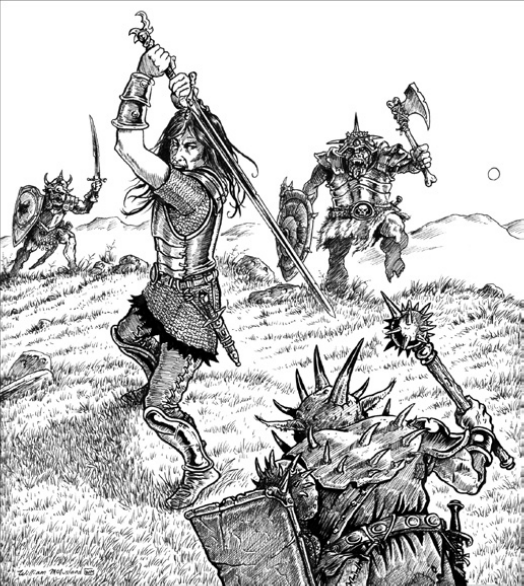
If I just hold my sword like thiiiiiis...
Only Heroes get to go toe to toe with military units on their own. Lone individuals and Support elements engaged by units are automatically killed, and if the unit they're attached to is destroyed they must save vs Death (as a level 1 Fighter if not otherwise specified) Support elements grant special abilities to the units they're attached to, and they can freely detach from an unit when it's their turn; they move at 120' a round and can spend a whole turn attaching themselves to another unit they're in contact, if they've trained together in the past. Heroes can also choose to integrate themselves to a unit, in which case they can't be deliberately targeted other than attacking the unit they're part of.
Sieges are handled very abstractly. Defenders must have some sort of fortification asset to force a siege, and then attackers can choose any number of their units and Heroes to attack the fortifications once a domain turn, which are hit automatically. The fortifications strike back at the assailants, but the attacker always chooses which units receive those attacks. Once the fortifications are down, the attackers may force an immediate battle against the defenders. It's assumed that Heroes and special characters can always find food for themselves in a siege, but units take 1 point of damage per HD each domain turn they're sieged unless Siege Supplies (a special asset) have been prepared beforehand to feed them. Attackers must also maintain lines of supply, by land or by sea if their numbers are large enough, which can be disrupted by enemy units and force them to also take attrition damage. Naval battles play out pretty much the same as land battles, with notes on needing special sea fortifications to push back enemy reavers and so on.
Taking a location puts any survivor defenders just outside of it, ready to launch a counterattack if they feel able to. A location's assets are immediately razed by the fighting, but rebuilding them has a +2 to the value checks for the conqueror. If the conqueror only wants plunder, however, they gain 1 Treasure plus one more for each asset, one more if it's a town and yet another more if it's a city. The location gains the Exceptional Poverty obstacle and assets plundered don't get the +2 to rebuild them, if it's even possible at the GM's judgment.
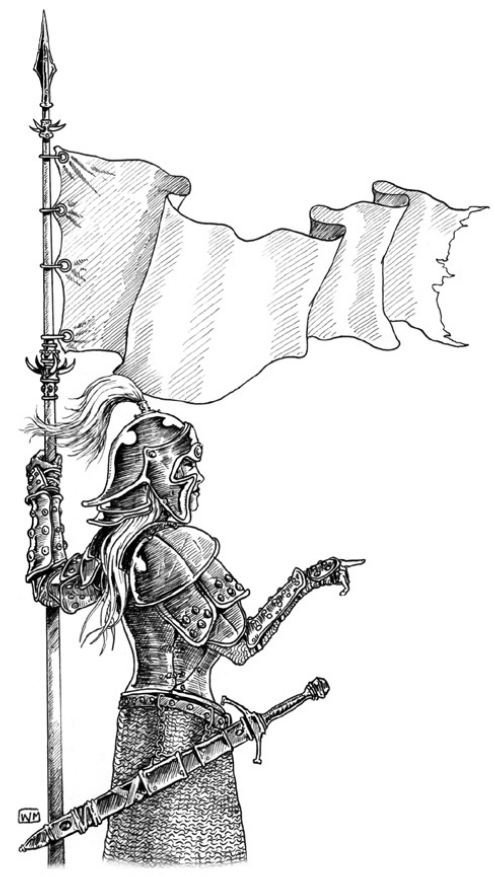
That guy has a fancier helmet than mine, kill him and raze his city.
Spellcasting is tricky. First, single-target spells or with a very small AOE are worthless against units, only useful against Heroes and even then, if they're attached to an unit they can't be targeted unless the caster has a particular ability to do so. Second, area-effect spells like Fireball can affect one unit, but one unit alone. Damage is reduced to one-half, with saving throws further reducing it to 1/4. Support elements must save vs Death if the unit they're attached to is hit by such a spell, while PCs take the same damage as the unit. Third, a mass combat round can take up to thirty minutes of in-game time, so most spells are only good for one round. Finally, spellcasters can't cast spells if they or the unit they're attached to are engaged in melee. It is possible that some casters develop spells that use the geomantic energies of a battlefield, and those could be free from these restrictions, but the supplement does not provide any example of such.
Finally, troops can gain War Experience. Each unit has a War Experience value equaling is total asset cost (so a unit that costs 2M0W0S has a War Experience value of 2) or its total HD if they don't have it. The survivors of a battle, both winners and losers, gain experience equal to the total War Experience value of the enemy side, divided by the friendly units that took part in the fight. As the unit accumulates experience, it progresses from Regular to Seasoned (5 War Experience), Veteran (15) and Elite (35). Elite units can't progress any further, but they still take up War Experience after a battle. Each time a unit rises in rank, it gains +1 to hit and one of these benefits, that can be taken only once: +1 HD, +1 Morale, the Hardened quality, the Skilled quality, or -2 to AC.
And now, the units themselves! We get a little lecture on why the three types of rolls (Military, Wealth and Social) need to be done to raise one, when you could just pay off some mercs to do the job. Sure, you could do that, but mercenary loyalties are fickle and they simply won't be integrated into the domain. Making the rolls means that a particular unit has been trained with the domain's forces, is in their formal payroll and logistic planning and has been organized into the domain's culture. Simple sellswords may suffice for a battle or two, but they might just find that the quickest path to riches is through their owner's holdings, while a properly raised unit will only turn against their masters by enemy machinations or gross mismanagement. The units themselves are divided into regular units, support elements and "foe" units, like Shou raiders and the undead. They're what you would expect in a fantasy wargame: there's your light infantry, your pikemen, your archers, your elf battlemages, your dwarf heroes and so on. Since it's a Red Tide book, there's also some ethnic variations of these, so you can get an Eirengarder Pike unit that is slower than regular pikemen but armored like a tank, or Kueh Samurai that have less AC than regular foot knights but are faster and get access to bow attacks. Plus, halfling units get a Morale score of 12, which basically makes them nigh-unbreakable.
 There's also some weirdness here: for instance, you can recruit a Sage support unit that costs 0M2W0S that only exists to solve Ignorance obstacles, or a Guardian Mage for the same cost that also has a Countermagic ability that grants rerolls to failed spell-induced saves in the battlefield. It's up to the GM, again, whether a particular unit can or can't be recruited by a Domain in a particular location. Men of Jade and Clay have the Stupid trait, which makes them prone to ignore orders unless a suitable unit with the Tamer ability has it (for instance, beasts with a beast handler, or undead hordes with a necromancer), but there are no suitable Tamers for constructs. Most notably, there are no units with the Guardsmen trait at all (except for the Red Jade Templars, a Shogunate unit most PCs will only see from the wrong side of their katana), but then again this might be on purpose since Guardsmen obstacles tend to involve a lot of PC-style adventuring and investigating.
There's also some weirdness here: for instance, you can recruit a Sage support unit that costs 0M2W0S that only exists to solve Ignorance obstacles, or a Guardian Mage for the same cost that also has a Countermagic ability that grants rerolls to failed spell-induced saves in the battlefield. It's up to the GM, again, whether a particular unit can or can't be recruited by a Domain in a particular location. Men of Jade and Clay have the Stupid trait, which makes them prone to ignore orders unless a suitable unit with the Tamer ability has it (for instance, beasts with a beast handler, or undead hordes with a necromancer), but there are no suitable Tamers for constructs. Most notably, there are no units with the Guardsmen trait at all (except for the Red Jade Templars, a Shogunate unit most PCs will only see from the wrong side of their katana), but then again this might be on purpose since Guardsmen obstacles tend to involve a lot of PC-style adventuring and investigating.
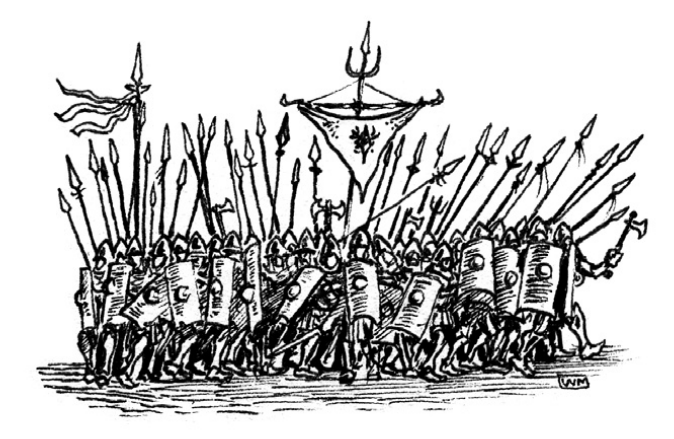
Literally the same stats as a 1HD mook, but when there's literally hundreds of them, enjoy becoming a pincushion. Unless...
Next: why do you cry for him?
You are our hero
Original SA post An Echo ResoundingYou are our hero
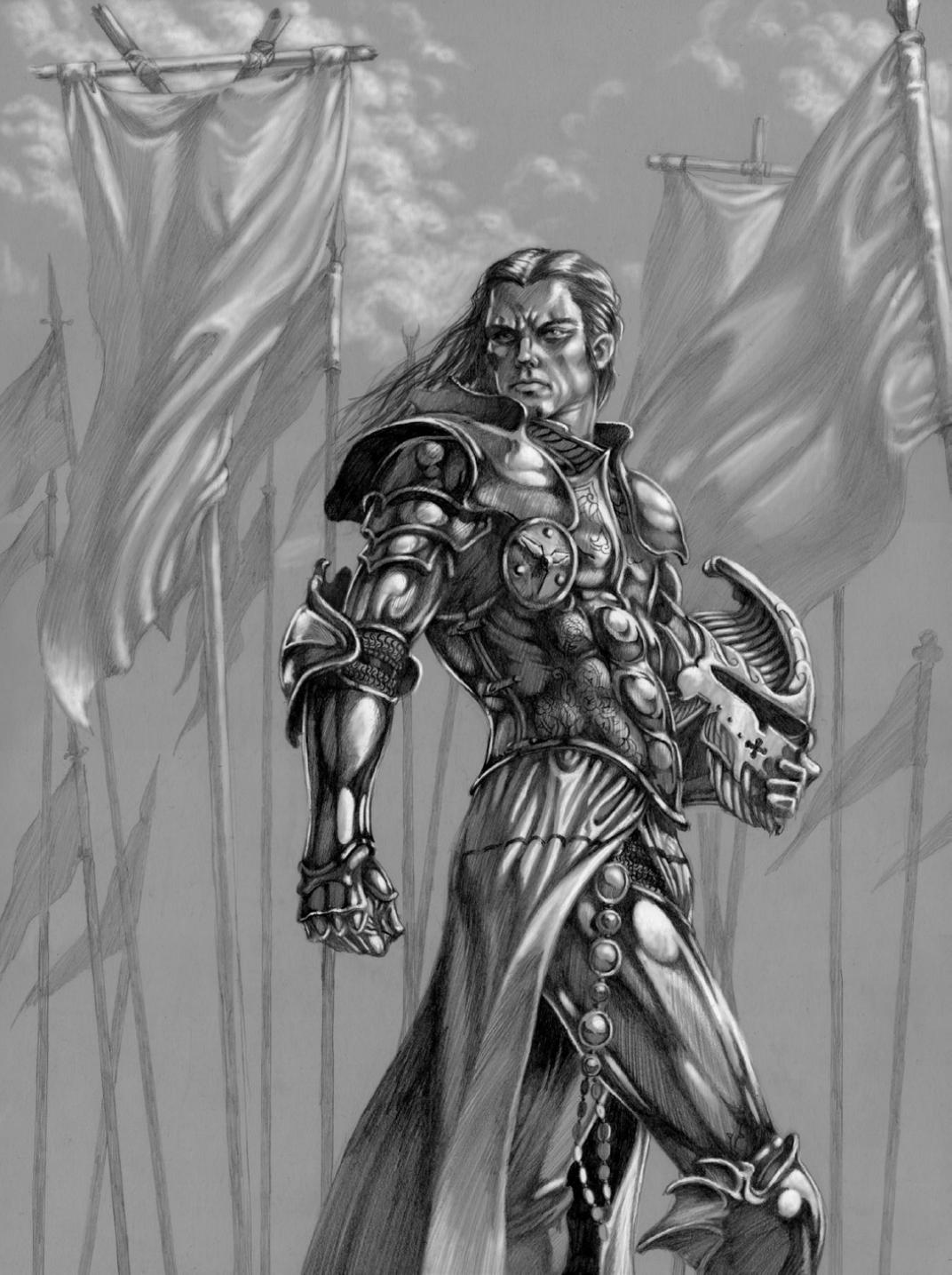
Dem thighs tho
A short one this time! PCs also get a lot of toys to play with here. Specifically, they get access to the Champion class. This class gives a myriad benefits to a hero that rules or serves a Domain. Advance in this class is parallel to regular advancement, you're not "multiclassing" by leveling as a Champion. The first level requires 25,000 XP, which puts first-level Champions at around 7th level for their regular class, give or take (remember that in old timey D&D classes had different XP leveling requisites) The Champion class does not modify HD, attack bonuses or any other stat, but it gives PCs a number of Abilities that interface with the domain rules. Some of them modify Domain stats, some can be used on the battlefield (and only on the battlefield), and some actually give the Domain a number of assets. If a PC loses levels due to energy drain or other effect, they can lose Champion abilities if they delevel enough, but assets gained by means of abilities are not disbanded unless the Domain cannot maintain them. Furthermore, a Domain can only benefit from a given ability once, unless they provide assets in which case the Domain only needs enough room to have them all. NPCs normally don't have Champion levels.
When a character gains their first Champion level, they get one ability based on their class, plus one selected by the player. If you're playing with those newfangled rules where race and class are different things, you can pick either the ability you get from your race or the ability you get from your class for your fixed ability. It's up to the GM what fixed abilities a new class would get.
-
Clerics get
Faithful Disciples
, which gives their Domain a Shrine in a suitable location
-
Dwarves get
Dwarf Friend
, which gives their Domain the Dwarf Friend domain custom.
-
Elves get
Burning Creed
, which gives their Domain the Burning Creed domain custom.
-
Halflings get
Halfling Affinity
, which gives their Domain the Halfling Affinity domain custom.
-
Fighters get
Martial Glory
, which gives their Domain +4 to Military.
-
Magic Users get
Studious Apprentices
, which gives their Domain three War Mage support units with no upkeep.
-
Scions get
Burning Creed
, same as Elves.
-
Thieves get
Sticky Fingers
, which gives their Domain +4 to Wealth.
-
Vowed get
Warrior Monks
, which gives their Domain two units of Warrior Monks with no upkeep.
While many abilities have prerequisites (for instance, only magic users get to benefit from Furious Sorcery , which gives battlefield-cast spells +1 damage per die and -1 to saves), many can be taken by most classes. Nothing says your Fighter can't be an Administrator (+2 to Wealth and Social for a Town or City directly under the PC's rule), or that your Cleric can't achieve Military Acumen (once a domain turn, automatically reduce a Military obstacle in 1, requires Fighter or Vigilant Watchman , which gives the Champion the Guardsman+3 quality) or that your Thief can't be Inspiring (Champion gets the Prophet+3 quality) to their people. Your Magic User could learn Arrow Deflection (PC and attached unit take half damage from missile attacks, doesn't work at individual scale combat though) and your Scion can be just Lucky (+4 to value checks or domain saves you make). Dwarves, maintaining the Red Tide tradition of
 , can become
Godhammers
(attached unit automatically hit extraplanar units in melee and deal maximum damage), while Halflings can be the
Last Ditch Defender,
(attached unit gains the Diehard quality; if it is reduced to zero HP by melee combat, they automatically hit the enemy that did them in)
, can become
Godhammers
(attached unit automatically hit extraplanar units in melee and deal maximum damage), while Halflings can be the
Last Ditch Defender,
(attached unit gains the Diehard quality; if it is reduced to zero HP by melee combat, they automatically hit the enemy that did them in)
The most interesting ability, however, is Hero . It has the heftiest requirements, needing a Champion level of 7 (at 650,000 XP, that's about 14th level), but what it does is turning the PC into a Hero in the battlefield, with their full stat spread and abilities. Which means that if a 14th level fighter charges a unit of Light Infantry with 1 HD and deals 9 damage in one blow, maybe they didn't disembowel a hundred soldiers personally , but they made enough of a gory impression that the unit disintegrates. But they're still one single individual and the weight of numbers matter - as we saw before, a Hero takes maximum damage from a military unit on a successful hit, and just regular damage on a miss. The game points out that considering the survival odds of a character against 8 orc units would be the same as considering the character's odds against 8 orcs that can always hit them but can attack one at the time. Since ranged units don't have this disadvantage, it follows that the best way to deal with Heroes is to reenact the end scene of the eponymous Jet Li movie. Even then, though, a level 8 Champion with the Hero ability can become an Invincible Hero and cut damage from military units in half.
 GMs may forbid taking the Hero ability if they don't want it in their game but come on, missing out a thief backstabbing a whole company of knights or a magic-user bashing the heads of a goblin horde with a quarterstaff? Some people.
GMs may forbid taking the Hero ability if they don't want it in their game but come on, missing out a thief backstabbing a whole company of knights or a magic-user bashing the heads of a goblin horde with a quarterstaff? Some people.
Next: the Westmark!
Demons, cultists, cyberdungeons!
Original SA post An Echo ResoundingDemons, cultists, cyberdungeons!
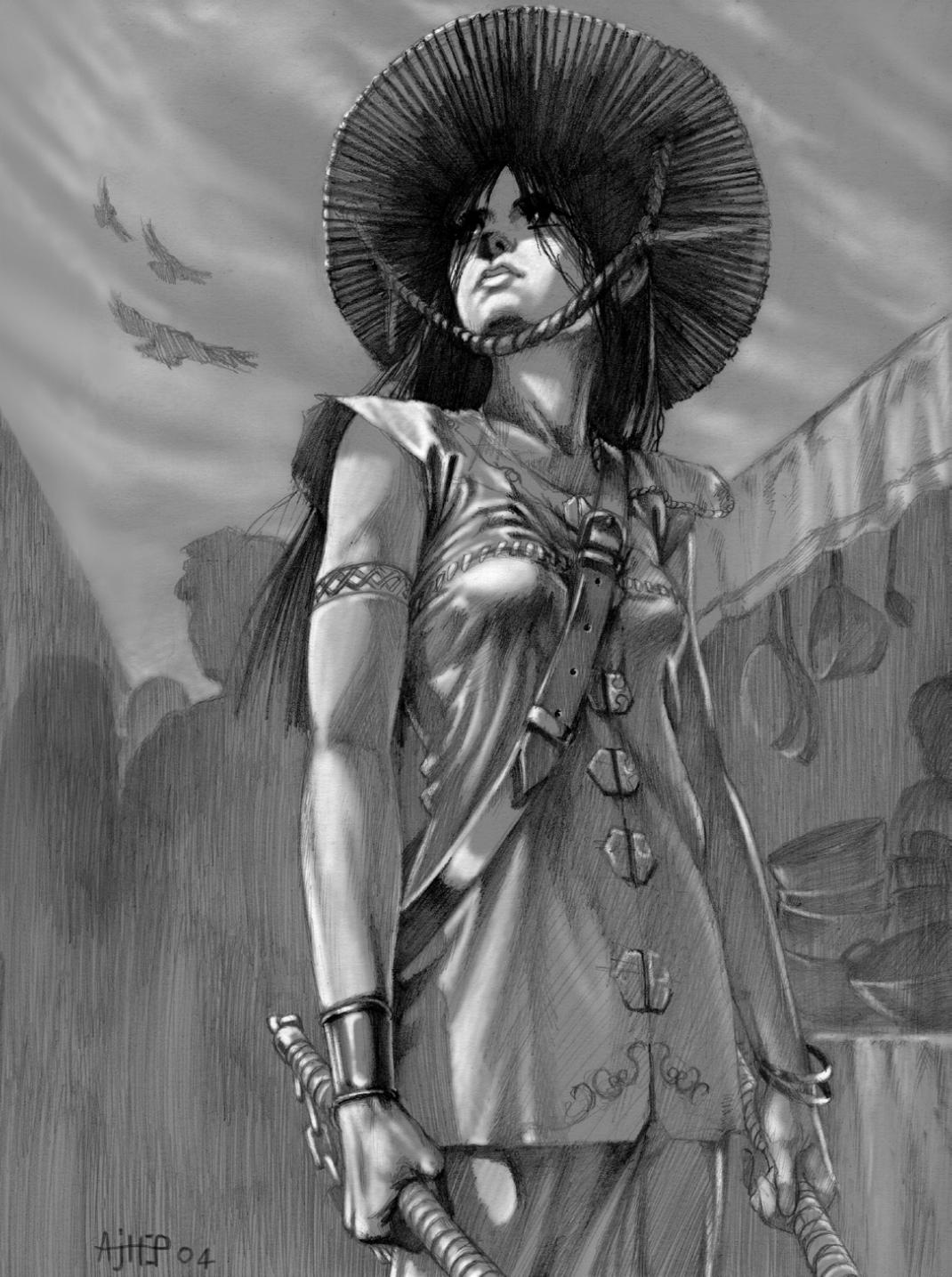
dem anime eyes tho
The book ends with a chapter on the Westmark. You know what this is from the Red Tide writeup, but AER does include a small outline of the setting if for some reason you purchased it without having read Red Tide first. Crawford writes that the Westmark's level of detail is overkill for a starting campaign - as he puts it, if a sandbox game needed forty-odd pages of preparatory material, precious few campaigns would get started. But hey, you paid for the book so you can have some of the work done for you. There's a map, in all its OSR hexagonal glory, and a list of locations for PCs to visit and adventure in, along with their stats and values. At least in my copy, however, some values don't quite add up, so you might want to check them manually before plopping them in a game. No Domains are established beforehand, however ; while some settlements are obvious starting points, the game might need a session or two before the GM can determine what powers the PCs have a greater interest in. Any Domains not chosen remain static until they come under their attention. By default, no Domain starts a game owning any part of the Westmark, but there's the expectation that they'll start annexing territory as the campaign goes on. There's an adventurer's guide to the location in the back, which is great because you can just hand these to players and they'll have a good grounding in the Westmark even if they've never heard of Red Tide before.
The Westmark is the harsh frontier territory that was once part of the Mandarinate of Xian, torn apart by the Ravaging of the Witch Queen Agrathi a hundred and twenty years ago. Recovery was slow and painful in the wake of the Shou horde, but men and women are returning to the Westmark: bandits, malcontents and outlaws, yes, but now also colonists and pioneers sent from the greater powers of the Isles. The place is choked by ruins to explore, treasure to plunder, valuable land to conquer, but the great powers are far away and their word is not law in the frontier. The locals are rough and hardy, not the kind you can push around with just a blade. It is a place of adventure!
There are only two true cities in the Westmark. One is Lintao to the north, rich and peaceful, but little loved by their neighbors. They drove away refugees in the days of the Ravaging and shut themselves in to survive, and it has a reputation for close-fistedness, particularly from descendants from the former province capital of Jinan , now a ruin dominated by a Shou chieftain that has made a terrible pact with the Hell Kings. These Jinanese riot in the streets and clash with the "native" populace (even though both sides have been born and raised in Lintao for decades), and the mandarin sent from Xian is way over her head and the locals accept her solely because she can be safely ignored. The other great city in the zone is Taian to the South, of a much worse repute than Lintao. It is an outpost of Tien Lung, formerly a place to exile losers in the arcane struggles of the magocracy, but the current ruler Lady Halah rebuilt the city and turned it into a powerhouse that dominates its surroundings. Chattel slavery is a matter of course, and the Lady Halah has ill designs for most settlements in the area, always looking to increase her power and cut off any would-be rivals either from the other powers or from her native Tien Lung. She's in cahoots with the Red House of the Maker , a heretical Makerite offshoot blessed by infernal powers, and the Screaming Stones , a reduct of Repenter dwarves that blackmails the High Priest Yevgeny of the Hammersong delve with the captured ghost of his late wife. Kur Darisum to the West is home to the Kuan Amelatu creed, elves that worship death - but they're far from evil, and in fact are the best exorcists and necromancer slayers around. Opposite to them are the Ghost Cloaks of Devout Hate , elves that follow the Wearers of the Mantle path and capture humans to use their souls as magic fuel. Machida to the east is many adventurer's first look of the Westmark, a town of cynical Kueh exiles that do a brisk trade in supplies for expeditions into the frontier and couldn't care less about anything else other than lining up their pockets and preserving their culture. Hamtun is Hohnberg's claim to the Westmark, but it was built as a military outpost first and as a livable place second - its residents are always on the brink of famine due to the poor but easily defensible lands around it. Tianfeng is a haven for runaway slaves, fully determined to never again be in thrall to Tien Lung or anyone else, but its leader is suffering for major PTSD and severely overestimates her chances against Taian. Tongren is where the refugees refused by Lintao went, and they harbor deep hatred for that city, also a Tide Cult unknown to them. Sallachy to the west is a Gadaal village blessed by incredible luck, with incredible jewelry work that not even dwarfmothers could hope to emulate, and cursed by wandering monsters. And so on!
And of course, there's enough trouble and places to explore to keep PCs busy. Leavetaking Hill , formerly a Tien Lungan slave plantation, and the Pagoda of Crimson Dreams , once a monastery, are now given to the cult of the Tide, eager to spread and infest. The Monastery of the Glass Viper is home to a malevolent Vowed order that teaches that kung fu is the path to ubermenschenhood and therefore they're justified in oppressing and enslaving all that aren't of the order. The Grass General's Fortress belongs to a mad sorcerer that now creates hideous half-humanoid, half-plant beings, while the Nest of the Six-Legged Army is crawling with things that resemble ants and men. One of my favorites is Vanguard Keep , the ruins of the first fortress to fall in the Ravaging. The huge number of deaths and spells cast in such a short time caused a geomantic effect that forces all the dead of the place to raise and refight that same battle every single night. Taking the Keep for a Domain's use requires getting rid of the curse, and that means protecting the undead castellan that commands the Keep's garrison, which is hard since he's one of the first casualties every time the battle is fought. It will take frenzied work to repair the Keep and break the old patterns of the battle (hopefully the undead won't break the half-complete repairs during the night!), or bringing in heroes able to literally slay hundreds of the dead on their own, to clear the curse. The other one I love is Yellow Teeth , a place of ill repute among the local Shou. Home to mutant, savage examples of their races, it is actually one of the original breeding centers from the Shou's own plane, malfunctioning after the shock of planar travel and centuries of abandonment. PCs have to deal with local security systems, great steel beasts, an invisible malaise that will kill anyone that steps inside certain chambers (radiation!), and degenerated Shou still pumped out from the functioning spawning vats that, without guidance or leaders, are now organized in a society where cannibalism is the only way to survive. And some of them are armed with rayguns! I'm a sucker for oldschool sci-fi stuff in fantasy games, seriously.
And that's it for An Echo Resounding, thanks for reading!